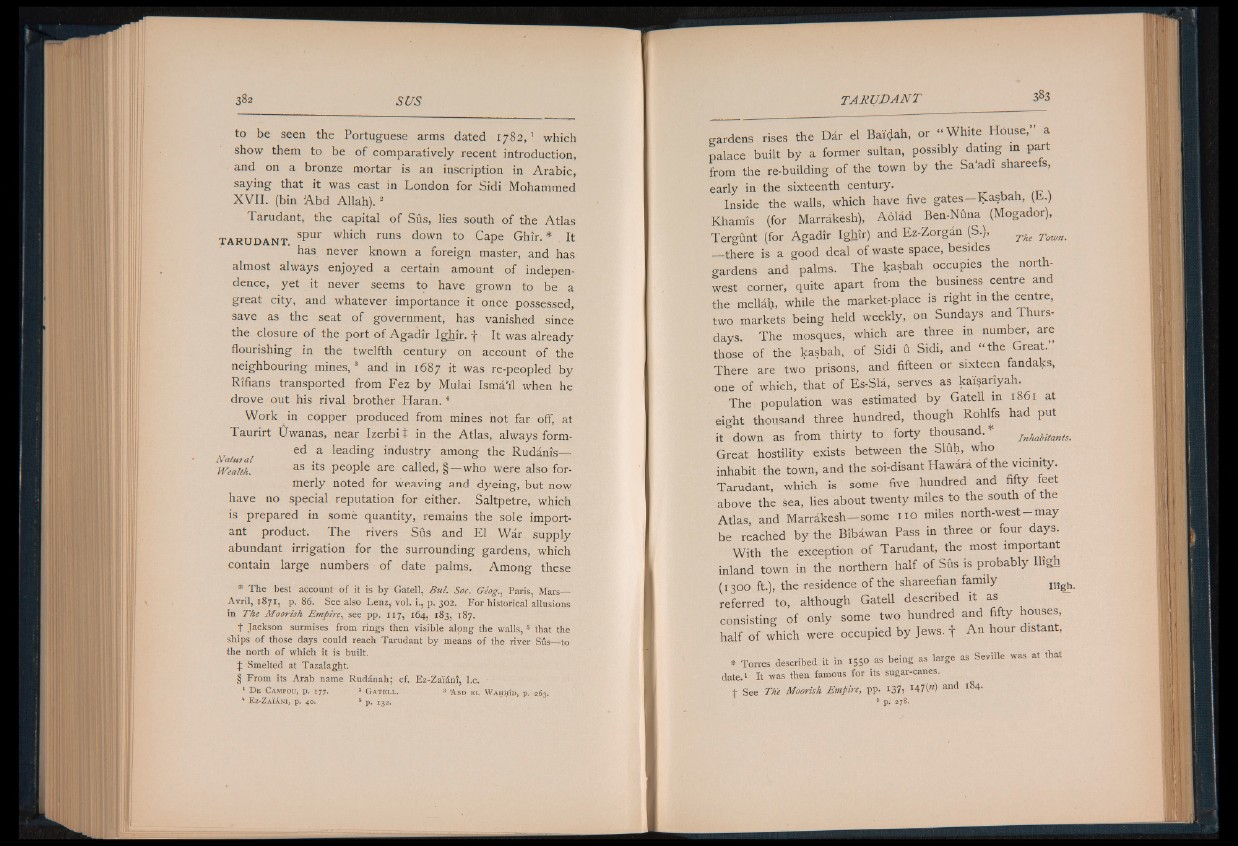
382 s u s
to be seen the Portuguese arms dated 1782,1 which
show them to be of comparatively recent introduction,
and on a bronze mortar is an inscription in Arabic,
saying that it was cast in London for Sidi Mohammed
XVII. (bin Abd Allah).2
Tarudant, the capital of Sus, lies south of the Atlas
T AR U D AN T . SpUf Which rUI1S d ° Wn to CaPe G h ir - 1 I
has never known a foreign master, and has
almost always enjoyed a certain amount of independence,
yet it never seems to have grown to be a
great city, and whatever importance it once possessed,
save as the seat of government, has vanished since
the closure of the port o f Agadir I ghir. f It was already
flourishing in the twelfth century on account of the
neighbouring mines,3 and in 1687 it was re-peopled by
Rifians transported from Fez by Mulai Isma'il when he
drove out his rival brother Haran.4
Work in copper produced from mines hot far off, at
Taurirt Uwanas, near Izerbit in the Atlas, always formed
a leading industry among the Rudanis—
Natural . . ,
Wealth. as people are called, §— who were also formerly
noted for weaving and dyeing, but now
have no special reputation for either. Saltpetre, which
is prepared in some quantity, remains the sole important
product. The rivers Sus and El War supply
abundant irrigation for the surrounding gardens, which
contain large numbers of date palms. Among these
* The best account of it is by Gatell, Bui. Soc. Geog., Paris, Mars_
Avril, 1871, p. 86. See also Lenz, vol. i., p. 302. For historical allusions
in The Moorish Empire, see pp. 117, 164, 183, 187.
t Jackson surmises from rings then visible along the walls, 1 that the
ships of those days could reach Tarudant by means of the river Sus to
the north of which it is built.
J Smelted at Tazalaght.
§ From its Arab name Ruddnah; cf. Ez-Zai'inl, I.e.
1 D e C a m p o u , p . 177. 1 G a t e l l . 3 'Abd e l W a h h id , p . 26 3 .
4 E z - Z a i a n i , p . 40. 6 p . 1 3 2 .
t a r u d a n t 383
gardens rises the Dar el Baidah, or “ White House,” a
palace built by a former sultan, possibly dating in part
from the re-building of the town by the Sa'adi shareefs,
early in the sixteenth century.
Inside the walls, which have five g a te s -K a sb ah , (E.)
Khamis (for Marrakesh), Aolad Ben-Nuna (Mogador),
Tergunt (for Agadir Ighir) and Ez-Zorgan (S The Town.
— there is a good deal of waste space, besides
gardens and palms. The kasbah occupies the northwest
corner, quite apart from the business centre and
the mellah, while the market-place is right in the centre,
two markets being held weekly, on Sundays and Thursdays.
The mosques, which are three in number, are
those of the kasbah, of Sidi u Sidi, and “ the Great.
There are two prisons, and fifteen or sixteen fandaks,
one of which, that of Es-Sla, serves as kaisariyah.
The population was estimated by Gatell in 1861 at
eight thousand three hundred, though Rohlfs had put
it down as from thirty to forty thousand. inhabitants.
Great hostility exists between the Sluh, who
inhabit the town, and the s o i - d i s a n t Hawara of the vicinity.
Tarudant, which is some five hundred and fifty eet
above the sea, lies about twenty miles to the south o f the
Atlas, and Marrakesh— some n o miles north-west-may
be reached by the Bibawan Pass in three or four days.
With the exception of Tarudant, the most important
inland town in the northern half of Sfis is probably High
(1300 ft.), the residence of the shareefian family nigh,
referred to, although Gatell described it as
consisting of only some two hundred and fifty houses,
half of which were occupied by Jews, t An hour distant,
* Torres described it in 1550 as being as large as Seville was at that
date.1 It was then famous for its sugar-canes.
+ See TKe Moorish Empire, pp. 137, 147(«) and i84-
1 p.' 278.